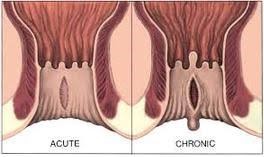Anal Fissures and Anal Skin Tags
What is an anal fissure?
An anal fissure is a tear or split in the skin of the anus. Fissures are small (like paper cuts) and sometimes are hard to see. Anal fissures are most often caused by passing a very large, or a very hard, or dry poop. It can also happen from diarrhea (runs) or pushing very hard to pass a large poop. In babies, fissures can happen from too much wiping. Anal fissures may cause pain, especially when your child has or needs to poop.
What are the symptoms of an anal fissure?
- Bright red blood on the formed stool or the toilet paper. Not all fissures bleed, but all are painful when they happen. They heal quickly if they are kept clean and not irritated with harder poop or diarrhea.
- Itching at the anus.
- Pain when they poop or even when they just have the urge to poop. It may be so painful that they try not to poop. This leads to worse constipation and more pain.
What is an anal skin tag?
Anal skin tags are extra skin at the opening of the anus. They are smooth, soft, painless, and flesh colored. It is common for anal skin tags to happen during childhood if your child has constipation problems or chronic anal fissures. The scar from the healing fissure can cause a skin tag. These tags can get red and painful if:
- the area is not kept clean.
- poop is large or hard and pushes on the skin tag.
What are the symptoms of a skin tag?
- There may not be any symptoms if the skin tag is small.
- A bump at the anus.
- It is the same color as the skin of the rest of the anus.

Reprinted from Shackelford's Surgery of the Alimentary Tract; Essani, Rahila, Fissure-in-Ano, 1864-1870., Copyright (2019), with permission from Elsevier.
How are these problems diagnosed?
Your child needs to see a provider. The provider will look at your child’s bottom. They can often find a fissure or skin tag by spreading your child’s butt cheeks apart to look at the anus. Sometimes a special light is needed to see small fissures.
How are these problems treated?
The most important treatment is to prevent constipation. Poop should be soft and normal size. It should flush easily. You doctor or nurse may also suggest other helpful treatments.
- Stool softener medicine. The medicine will soften your child’s poop. This makes it easier for your child to poop.
- Diaper cream or ointment like Desitin® or zinc oxide. This can help with pain or itching. Putting this on the anal opening helps heal and keep the opening moist so pooping becomes less painful. Some children need a prescription cream that relieves pain and helps the anus to heal.
- Diet changes. Your doctor or nurse will talk to you about changing the food your child eats. Your child will need enough fiber and water. This may help keep their poop soft.
- Loose clothing. If your child wears underwear, loose fitting clothes help air flow around the anus. This will keep the area dry.
- Bath. Some children feel better if they soak their butt in 2 to 3 inches of warm water each day. The bath should not have soap or bubble bath in it.
- Wet wipes. Use after pooping.
- Avoid wiping child’s bottom firmly as this will re-open a healing fissure.
Will my child need surgery?
Surgery is rarely done in children. Your doctor will let you know if it is needed.
Other teaching sheets that may be helpful
- 1844 Constipation
- 1761 Hemorrhoids
- 1471 Increasing fiber in your child’s diet



